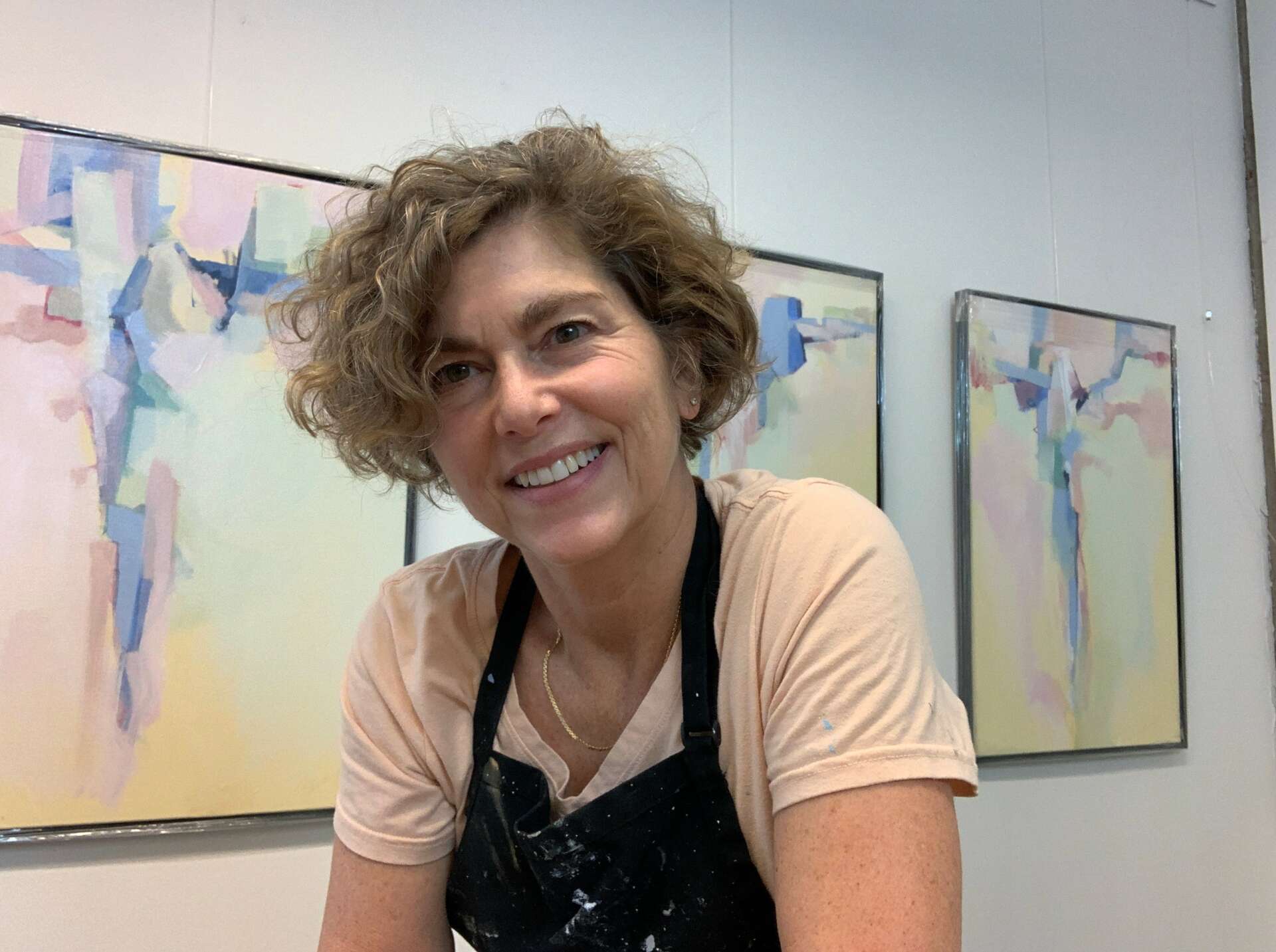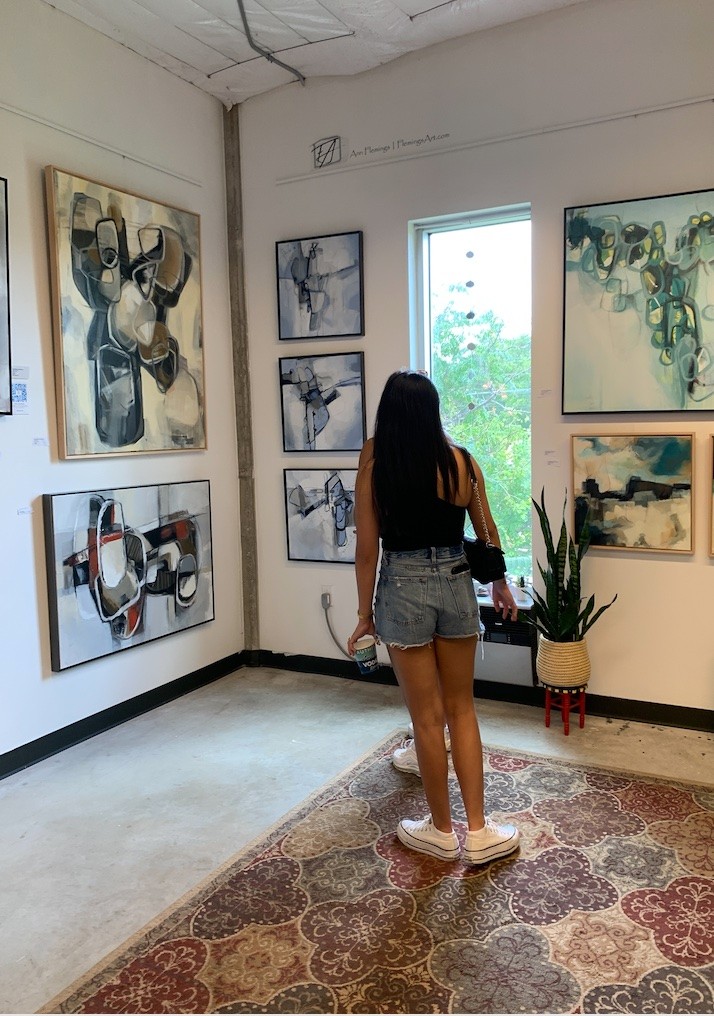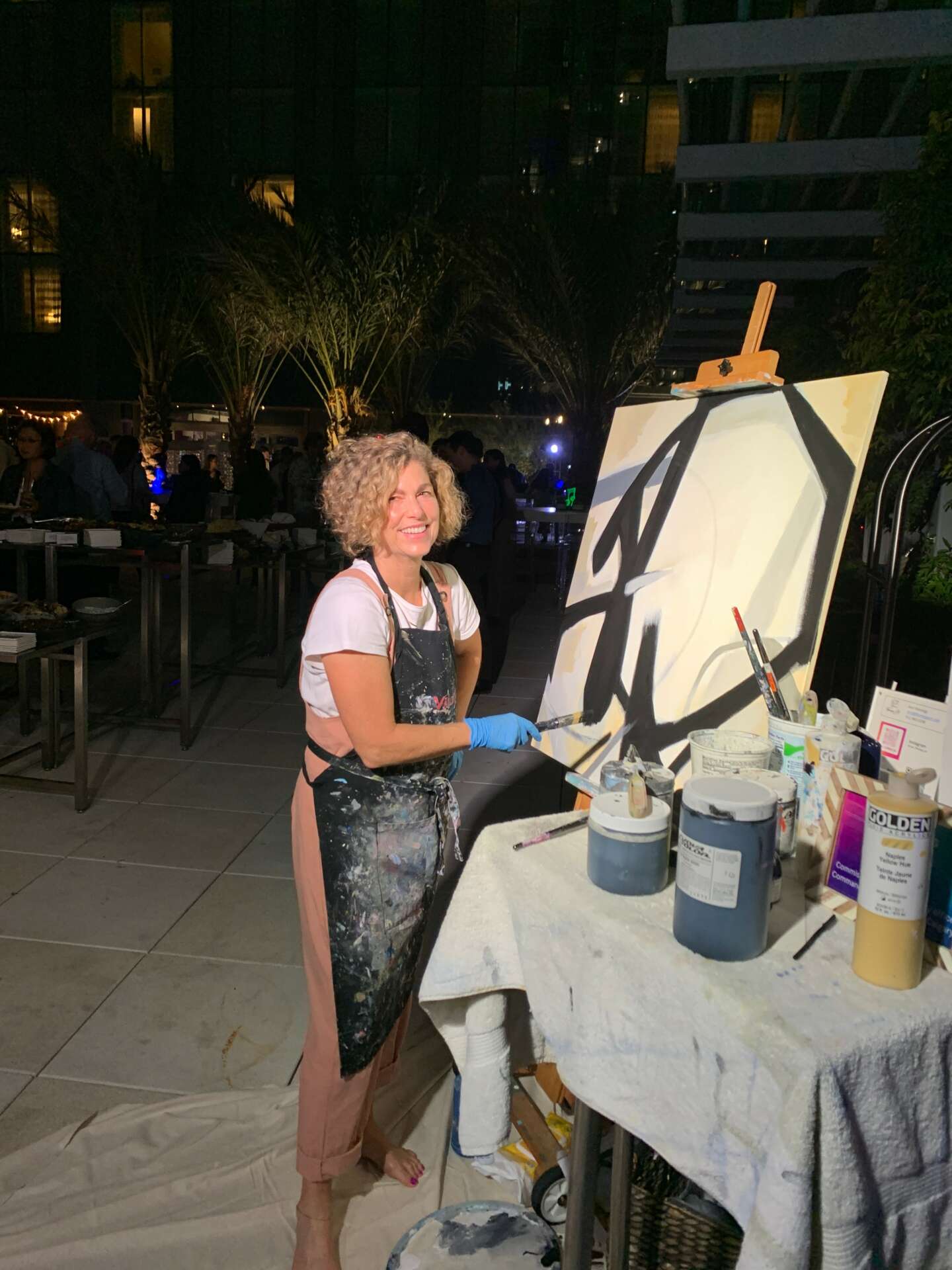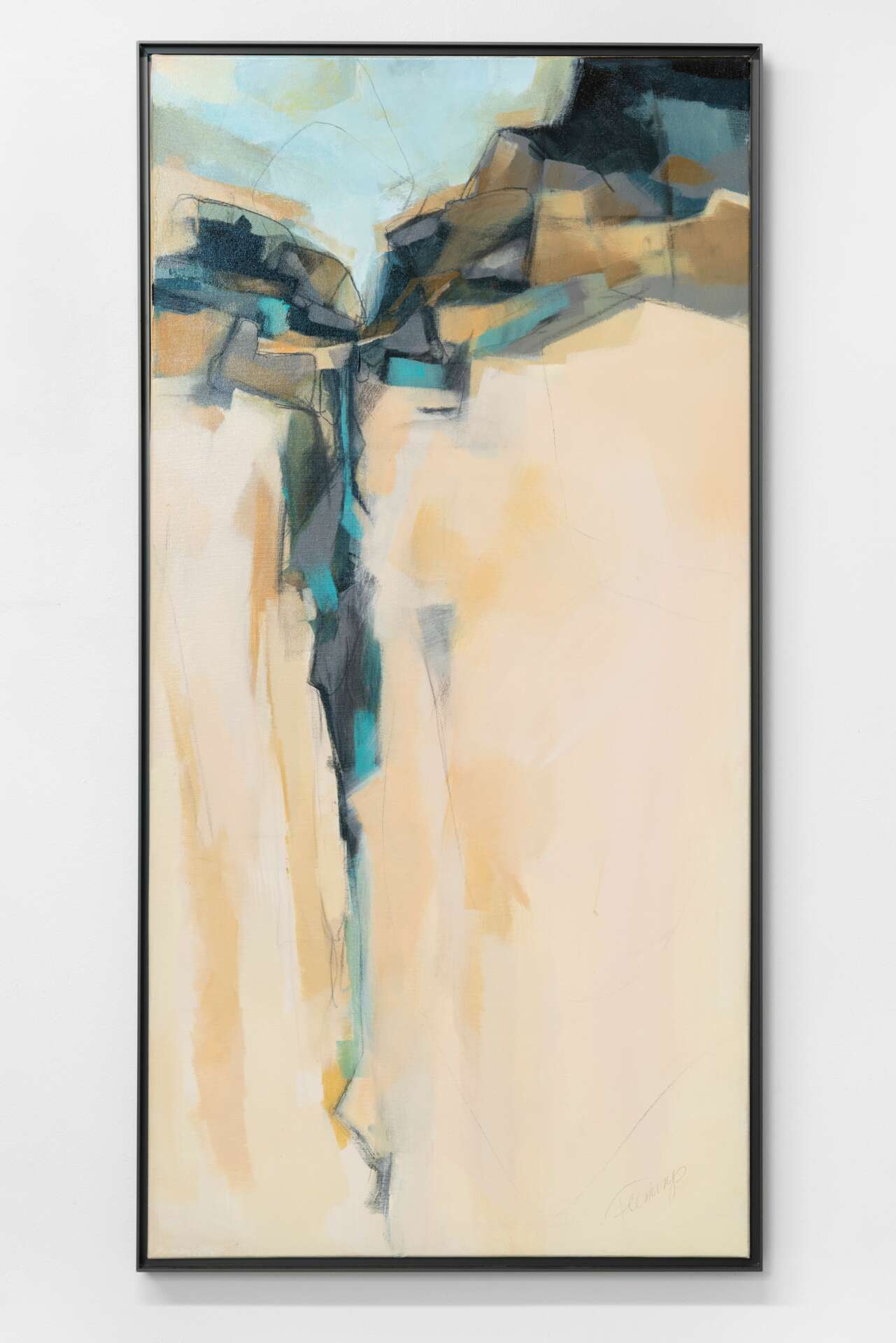We caught up with the brilliant and insightful Ann Flemings a few weeks ago and have shared our conversation below.
Ann, appreciate you joining us today. We’d love to hear about a project that you’ve worked on that’s meant a lot to you.
As a contemporary abstract painter, I always had visions of painting “big”. In 2017, I was in a small studio, and I didn’t have the space to easily paint at a larger scale. I decided to undertake a self-designed residency. I planned to rent a large painting space and work on ten, 4-foot by 4-foot canvas. My plan was to use 8 weeks of focused time to learn how to scale-up to larger sized paintings.
I worked out a trade with an artist friend with a large studio – I would pet-sit while he was on vacation, and I could use his studio space. I planned to use the space from July 1 through August 31. I used the month of June to prepare small study paintings in my studio to use as a reference during the residency. I purchased larger brushes, deep containers for mixing paint and metal pizza pans to serve as mixing palettes. I set up ladders to serve as easels in the larger space. I bought ten large gallery-wrapped canvases. The huge canvas’ were not intimidating, they excited me. I wanted to make huge marks on those blank spaces, fill them up! I was excited to begin the journey. I used my reference paintings as a starting point, laid out compositions on the canvas’ using charcoal and started painting on July 5th.
I quickly learned that scaling up a painting has its own set of challenges. Since I was used to painting with smaller brushes and less paint, I had to learn how to mix bigger batches of consistent color and to wield large brushes effectively. I learned that taking an image from a smaller to larger canvas requires some finesse. I covered the studies with a tracing-paper grid to help me translate the images to the larger surface. I started vigorously and energetically making marks, but gradually, the work output began to slow down. The bigger canvas’ were taking more time to “talk back to me” and tell me what they needed. There was simply more space to fill. I continued to persevere and was making modest progress on four canvases out of ten.
Fast forward two weeks. I am still working on the four originals and there were no quick moves at the mid-point. The studio space was spacious, but there were issues. There was no air conditioning and I live in Texas. Did I mention it was July?! There was a hose for washing brushes, but no bathroom. Because of the lack of AC, my paint was drying at an exceedingly fast rate. Remember, I had learned to mix large quantities of color. I would arrive in the morning to discover the paint had to be revived with gel mediums and water. This changed the texture of the paint, and it didn’t flow as effortlessly from my brush, which stymied my working process. I continued painting and eventually finished two paintings. I continued working on the other two canvas’.
At the end of four weeks, I decided that I wouldn’t be able to finish the final four weeks. I measured the walls in my back bedroom and there was just enough space to hold one large canvas. I chose to finish the last two at my home in August.
The best thing that came out of this Self-Directed Residency experience was encountering all the challenges that come with scaling up your artwork. It was frustrating but offered wonderful lessons. I now simply LOVE painting large. Now my only limit is the size of canvas that can fit in the back of my car! I am proud of myself for undertaking a challenge and coming through to the other side. It built my confidence to tackle this project and work out the kinks, for better or worse. Also, the self-directed residency concept is a great strategy to use to explore concepts that might be appropriate for a formal residency application in the future. Who knows, I may be up for another Self-Directed Residency in 2023!




As always, we appreciate you sharing your insights and we’ve got a few more questions for you, but before we get to all of that can you take a minute to introduce yourself and give our readers some of your background and context?
Born in LA and raised in Pennsylvania, I am a contemporary abstract painter living in Austin, Texas. After graduating from college with a BFA, I had a fulfilling career in fundraising with academia and non-profits. In 2015, I began to bring art back into the forefront of my life and haven’t looked back since!
Now, I create vibrant, original art that evokes a sense of peace and beauty through the process of layering, excavating, and revealing. Drawing from memories, moods, and the paint combinations on my palette, I start with a loose composition of shapes transforming the piece through many stages. I incorporate mark-making into my work and strive to maintain the energy of my first efforts because these efforts are my most authentic.
I am an intuitive painter, influenced greatly by emotions and feelings. I allow the painting to direct me where it needs to go. Part of my process is to continually become a better listener in a visual sense – I closely look for the clues the painting is trying to express and then bring that to life. Every painting has a story to tell, every painting has its own soul.
That is the wonderful thing about having original art in your home – it brings a personality and spirit into your space to be enjoyed for years to come.
I hope my work evokes a sense of calm energy and a feeling of balance and peace. There is a great Buddhist phrase, creating “relaxed spaciousness.” I call on this notion in my life and my work and hope my art conveys that feeling to the viewer.
How can we best help foster a strong, supportive environment for artists and creatives?
All of us can support the arts in large and small ways. Attend an exhibition opening, become a member of a museum, attend local art shows, buy original artwork directly from artists and make contributions to arts-related nonprofits. Use your voice to vote for local, regional and state-wide representatives that support the arts and a thriving creative class. Encourage friends and neighbors to join in with you and support the creative ecosystem of your city. We can all do our part to help the arts and artists thrive.
We need artists today more than ever to share beauty and offer time for reflection. One of my favorite artists, Brian Rutenberg, says he gives the gift of “slowing down” through his art. Really looking at a piece of art requires that you slow your mind, take a pause from the busy-ness of the world and experience another view. Looking at art encourages you to “breathe.”
What you bring into your life and home is an important consideration. To me, finding an original artwork that speaks to you is a special moment. I create my work to bring joy and beauty to others and their living spaces. My greatest pleasure is to bring a smile to someone’s face through my work.
I like to share my work, so I strive to put my art in front of as many people as possible. I share my work on social media, but the best way to experience art is the old-fashioned way – in person. Being with a piece of original, hand-made art – taking time to hear its story – is a unique space in our very slick techno-world.




Let’s talk about resilience next – do you have a story you can share with us?
In 2015, I decided bring art to the forefront of my life and down-tick my professional fundraising career. To help myself launch this important phase of my life, I decided to meet with a working artist I knew socially and seek some strategies for success. I was asked to bring paintings along to share and upon arrival, I discovered that this was a full-blown portfolio review. It did not go well. I was told I had a weak sense of composition, my color use was too bright, that I had no focal point in my work. I had just turned my world up-side-down for art and I was being told, by someone I respected, that my work stunk. I was devastated.
After a great deal of processing, gnashing of teeth and a few tears, I decided to take a more practical – not personal – approach to her comments. This allowed me to look at the problem objectively and I decided to strengthen the foundations of my craft. I began to participate in a weekly life drawing group. I discovered “notans” and frequently practiced them using photographs from my phone. I worked with a well-respected teacher who took me from the basics of drawing on up through painting and color mixing. I trained my eye and worked hard to discover the nuances of line, tone and value.
It wasn’t easy. There was a great deal of frustration in the studio, on the sketch pad and with myself. I learned that I had a good eye, it just needed practice. I received feedback that my sense of balance was strong. I loved color but began to appreciate the nuances of tone and value. In the end, I became a much stronger artist. One full year later, I opened my studio to the public and my work was well received. People appreciated it, talked with me about it and purchased it. I had really grown as an artist.
I hold no animosity toward the artist that gave me that review; however, I wouldn’t recommend that experience to anyone. In many ways, I am grateful for her courage to share her views because it made me work harder to be better. To quote Nietzsche, “that which does not kill me, makes me stronger.”
Contact Info:
- Website: Www.Flemingsart.com
- Instagram: https://www.instagram.com/ann_flemings_art/ @ann_flemings_art
- Facebook: https://www.facebook.com/AnnFlemingsArt @AnnFlemingsArt
- Youtube: https://www.youtube.com/channel/UCP4-gS30SG8E0ijELjGDKfw/featured
Image Credits
Alex Boeschenstein


